Calathea plants are so outrageously beautiful they are almost irresistible in a plant shop. However calathea care is tricky. They are sensitive to their humidity, water and soil conditions. Study this Calathea Care Guide carefully to learn every detail of how to keep them thriving.
Once you learn the correct growing conditions for these beauties you will love them.
Calathea plant care is not especially difficult. You just need to know and give them what they require. If you make a mistake they will show the stress.
Fortunately, Calatheas are fairly tough. Once you correct the problems they will often recover.
When you discover your favorite calathea type expect to fall in love with it.
Calathea plants come in over 300 gorgeous varieties. Can’t pick a favorite? Start a collection. That’s what I did. 🙂
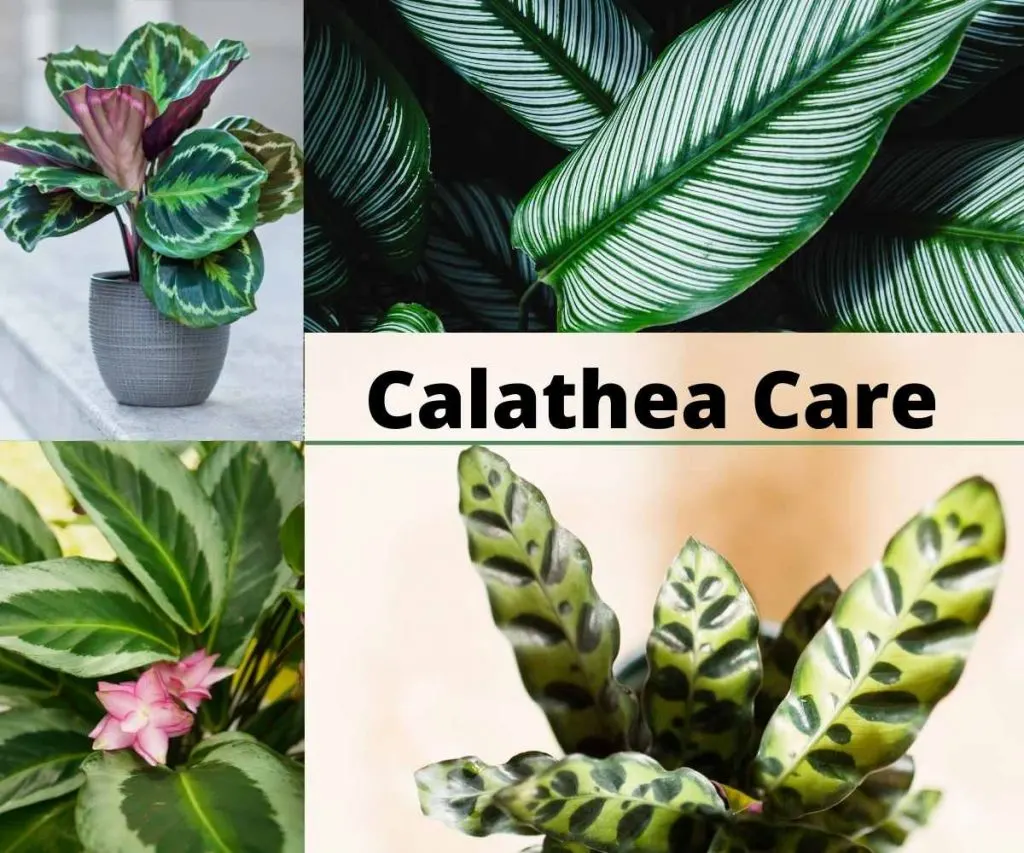
Calathea Information:
Calatheas live in tropical rain forests. In the wild they populate the lowland rain forests of Brazil and Africa. They live on the forest floor under the tree canopy where they are protected from strong direct light and heavy winds.
The water in their native environment is soft, acidic rain water filtered through the forest floor. It’s low in minerals. This is a BIG deal for Calatheas. If you water them with regular tap water chances are they won’t like it.
The forest have mostly stagnant air without much breeze or temperature changes. These plants are happiest in still air at 65 to 75 degrees F with humidity of 50 to 60%.
Not much changes in the natural world they are suited for. They don’t adjust well. If you try to challenge them with conditions outside their comfort zone Calatheas will complain loudly with poor foliage, drooping leaves and rotted roots.
Plants in the Calathea genus are in the family Marantaceae (arrowroot family). Recently about 200 of these plants were moved to the genus Goeppertia. For more on the Classification of calathea plants read this. For now you will find all your favorite Calathea plants tagged as Calatheas in plant shops and online shops.
Calatheas are similar to Maranta plants However, They have differences in their coloration patterns and leaf shapes. Marantas can also trail and make an interesting hanging plant.
Calatheas exhibit the praying hands reaction to light. But Maranta Leuconeura is the original prayer plant.
Calatheas grow as upright bushes. They make great table top plants, windowsill plants or bushes for a boring corner. The foliage is exciting and dramatic. Wherever you put them calatheas will steal the show.
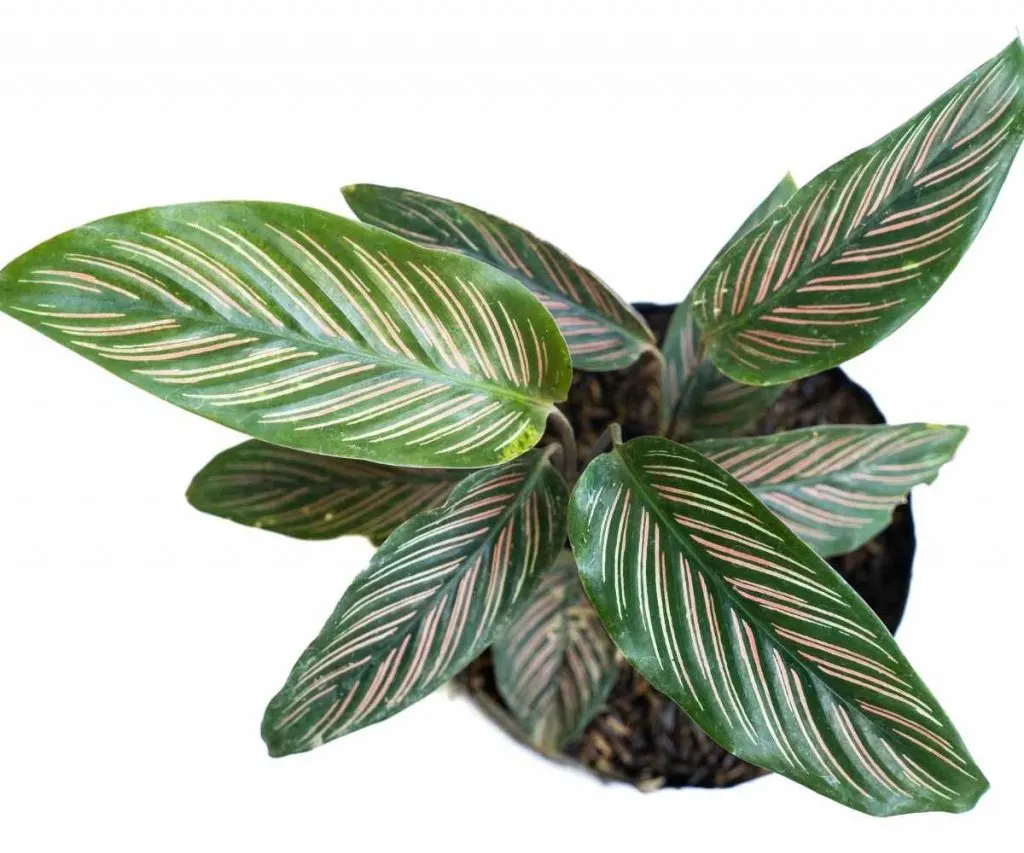
Growing habits:
A huge variety of exotic leaf patterns and colors are available from this genus. Most Calathea types have a low bushy profile. Several of the varieties grow to to 24 inches tall or so.
When you choose one they will normally be immature plants. Be sure you know before you buy how large the plant gets.
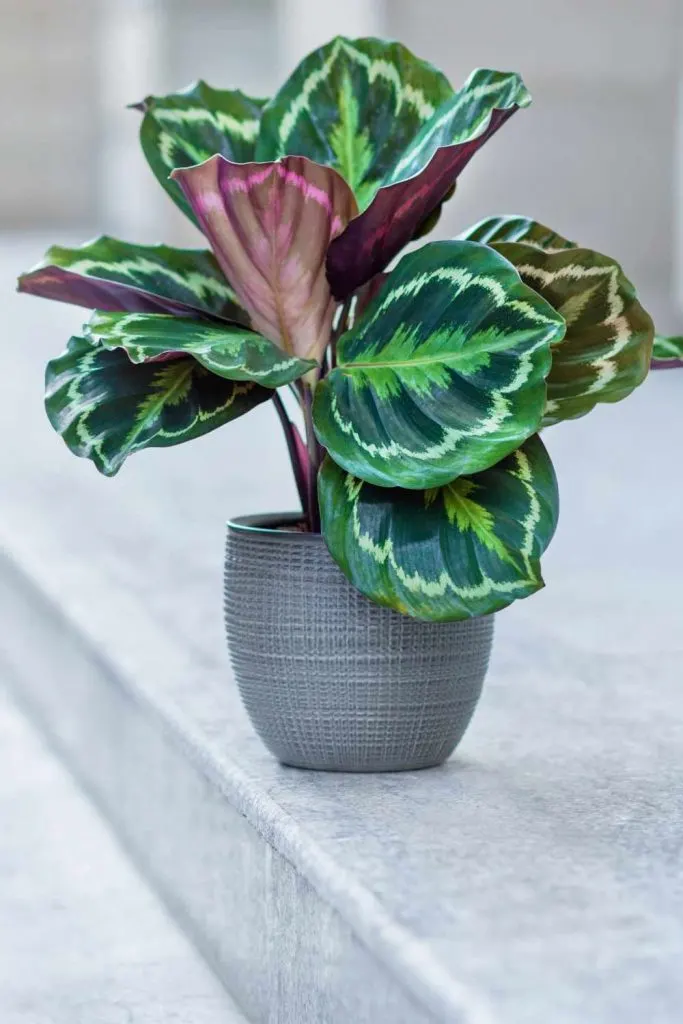
Calatheas grow from rhizomes that tap into the rich soil nutrients and keep them well fed. We propagate mature calatheas by rhizome and root division.
Beware dividing a very young Calathea. They may not recover from the shock. Let them grow up and then divide them at repotting time every couple of years.
Purchase Calatheas on Etsy
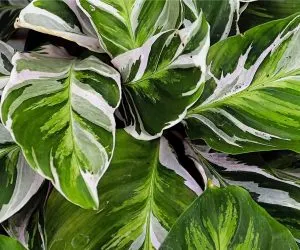
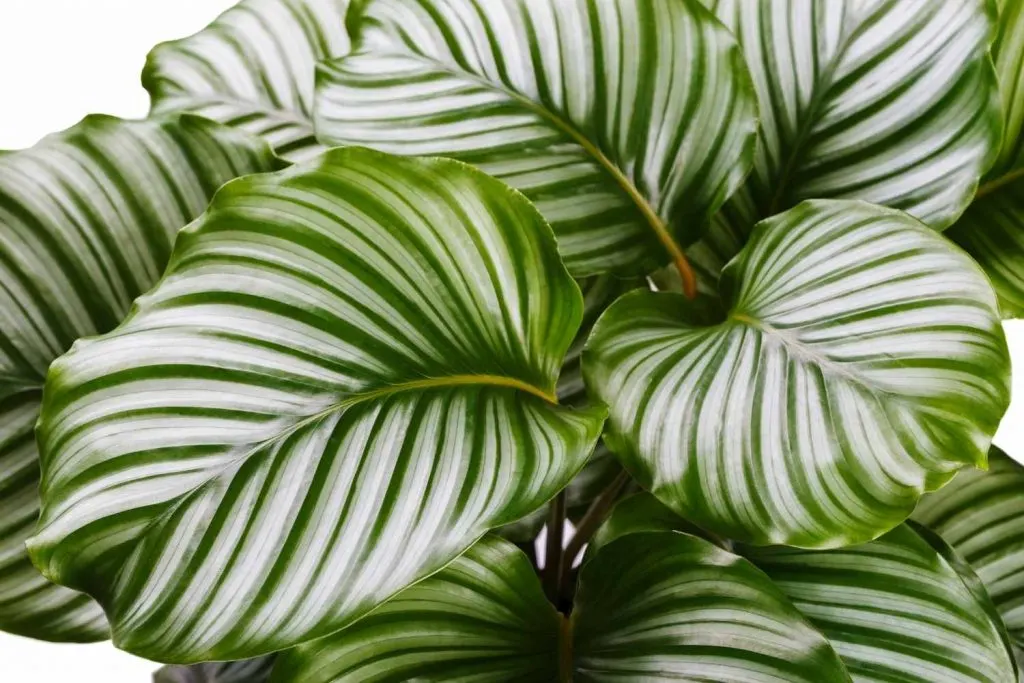
Calathea Care:
Once you learn the language of plants it’s pretty easy to see when they have a problem.
Persistent curling brown edged leaves, drooping and fading foliage are clues to their unhappiness.
However, It’s normal for the leaves of an established Calathea to have a brown edge or two. Thickly planted bushes may have dead leaves occasionally in the center of the plant.
Simply trim off the brown with clean sharp shears to spruce the plant up. Cut off dead leaves at the soil line and remove to clean up the plant. This also helps avoid fungal infections, pathogens and pests.
They are often plagued with fungus gnats. Spider mites can be a problem if they get a foothold in your Caltheas.
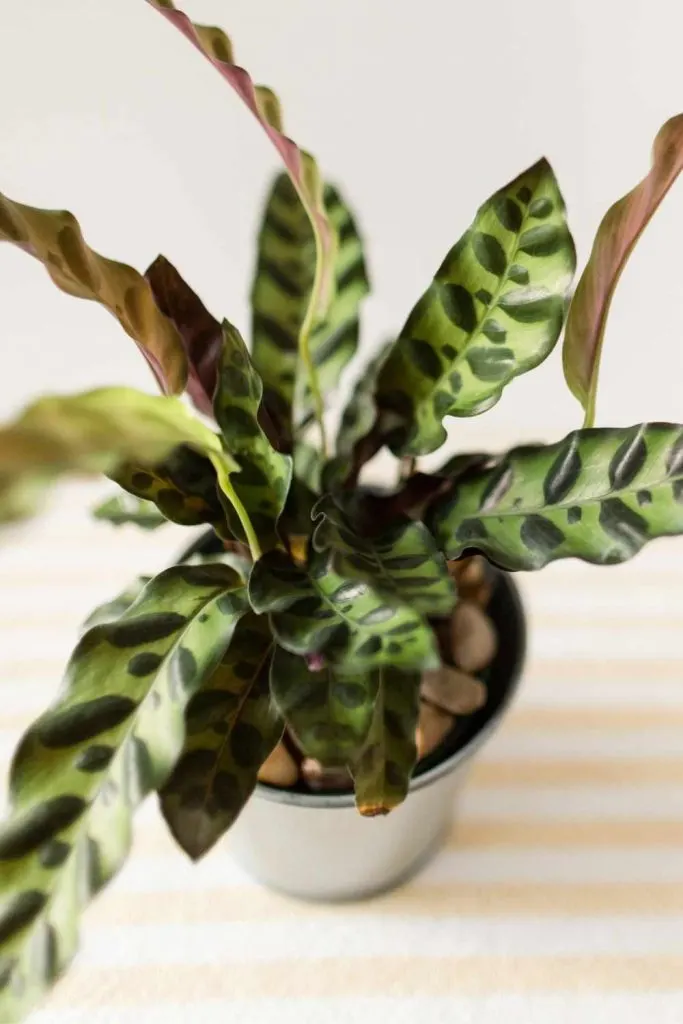
Calatheas are perfect plants for nurturers. These are not ‘set it and forget it’ plant babies. They need a watchful eye and monitoring.
They reward us with amazing foliage and even the occasional small flower. But even small flowers are amazing in the proper plant.
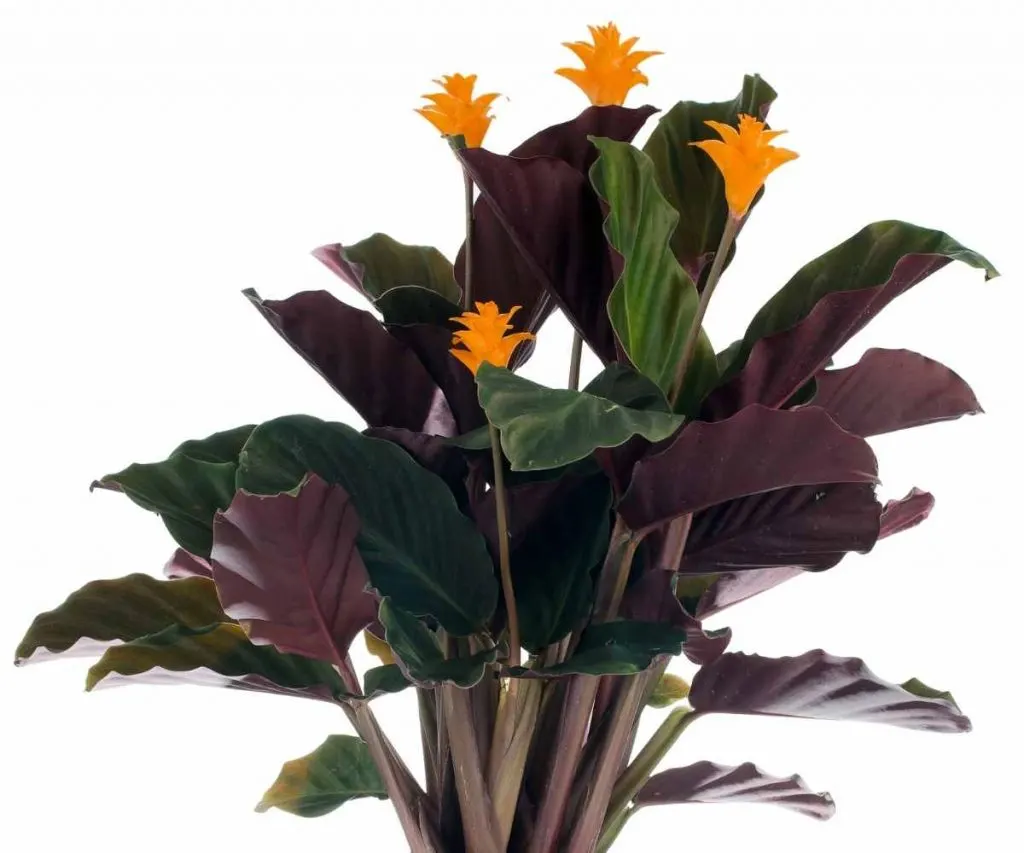
All Calatheas are non toxic to your pets and children. Finally, Calatheas purify your home air of certain toxins as they respire.
Take care of them and enjoy the benefits of these lovely tropical plants.
How to Care for Calatheas:
Unlike easy care tropical plants like Scheffleras, Calatheas are finicky. They will suffer if they don’t have acceptable growing conditions.
Read our printable care guide below for a complete guide to caring for this amazing family of plants. They do require more looking after than easy care plants like Pothos, Tradescantia and Peace Lilies.
But Calatheas make a perfect living focal point in a room. They are so lively and eye catching.
Our growing guide will also show you how to propagate calathea. It is rather simple really. You will find that once you learn how to keep Calatheas happy they will reward you greatly for many years to come.
Calathea Care Guide
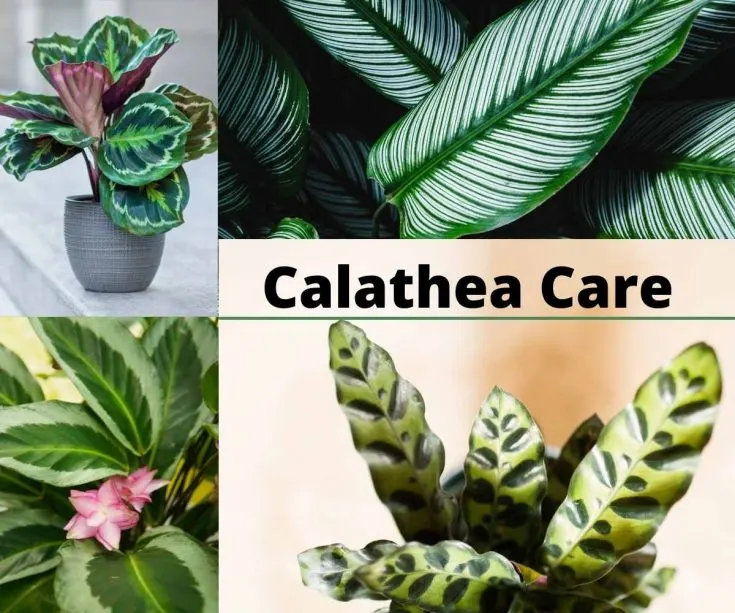
Calatheas are beautiful, exotic plants with wide appeal. Their care needs are specific and important. They are sensitive. This is Not a forgiving plant group.
Once you find the perfect growing conditions for your calathea it will perform well for you.
Learn what they need and give it to them. Their lovely foliage (in some cases they even flower) are so worth the effort!
All Calathea plant care is similar. No matter what type you own this care guide will apply.
Materials
Tools
Instructions
Soil Preference:
- Calatheas enjoy a light well draining soil.
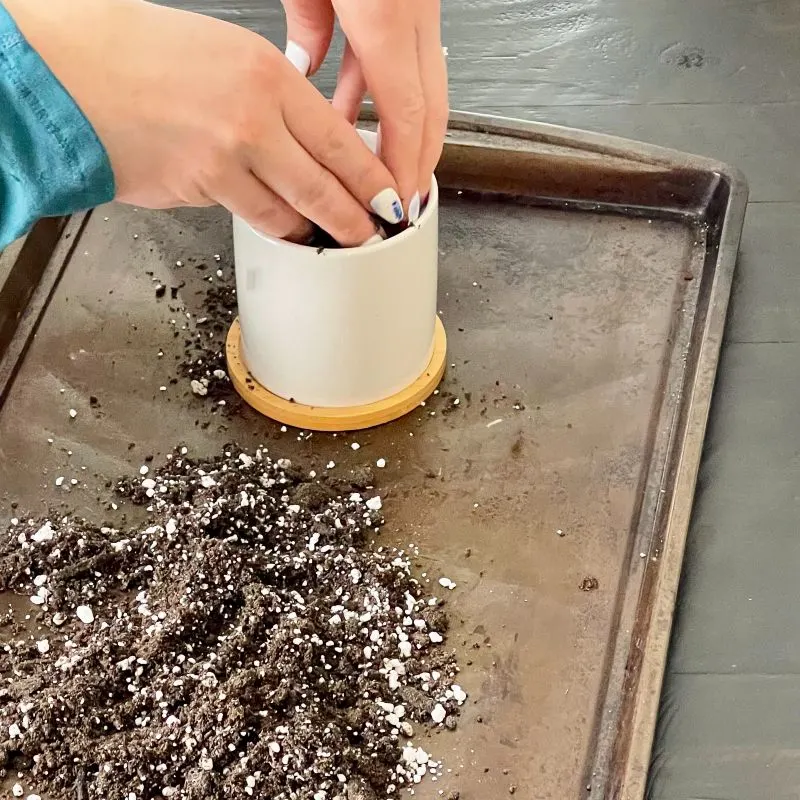
- A mix of potting soil and perlite will keep the roots happiest.
- Our mix for this plant is 30 % potting mix, 30% succulent mix to 30% perlite.
- A heavy soil potting mix is not recommended for these plants.
Pot Size and Type: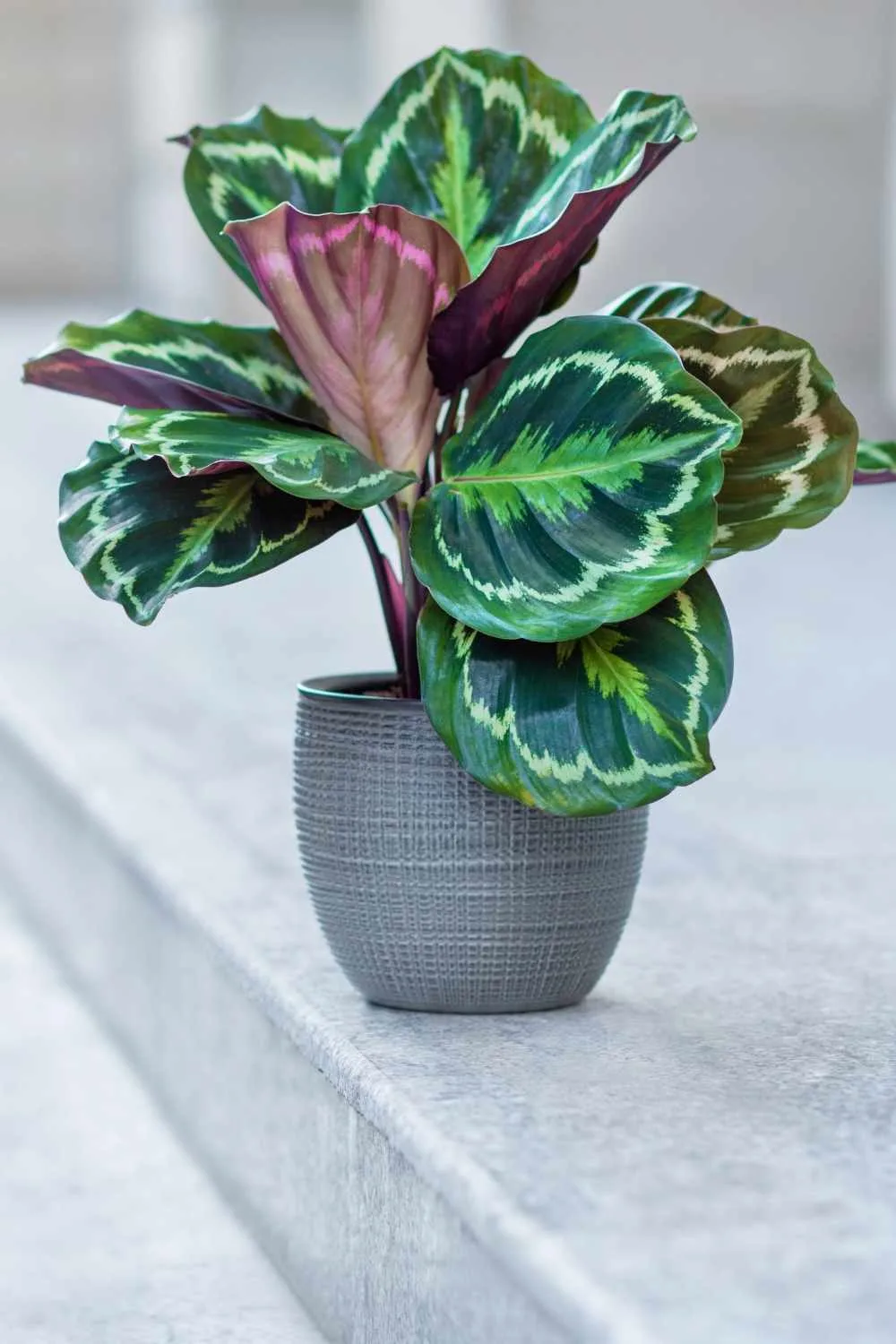
- Calatheas grow from rhizomes. And they grow new offshoots to the sides of the mother plant.
- This means they will fill a pot out as a wider plant eventually. Quite a nice table top centerpiece.
- Some of them can trail and be used for a hanging plant as they grow.
- Calatheas will grow to the size of its pot. If you leave it to grow as a grouping in one pot you will need to find a pot that is shallower and has a wider circumference. They do not like to be overly root bound.
- If you want to encourage faster growth choose a pot about 2 inches wider in diameter than the current pot.
- Any well drained pot can be used. It MUST have excellent drainage.
- Terra cotta pots are not recommended. They will wick too much water away from the soil.
- Repot every second year or when roots come out the drainage holes on the pot bottom To the next pot size up.
- Don't jump to a huge pot from a small one unless you wish to encourage faster growth. Just go to the next size up pot.
- For Calatheas self watering pot systems work well. (linked above). They control the watering for you and help avoid root rot, overwatering and under watering.
- Calatheas enjoy evenly moist soil so self watering systems help here.
Lighting:
- Calatheas all enjoy indirect light for best leaf variegation and optimal growth.
- Different species are fussier than others but as a general rule if the leaves fade move to a less bright area and see if that helps. Too much light can fade the leaves and crisp the leaf edge.
- It will tolerate lower indirect light but the plant may grow more slowly. Leaf variegations may not be well expressed.
- Shield this plant from strong direct light in summer south and west sunny windows. The leaves will burn and the colors will fade. Look for dry brown spots on the leaves and curling brown edges. If you see them move the plant to lower light.
- Tip: Window sheers or blinds can offset some brief periods of high direct light.
Watering:
- Calatheas are VERY sensitive to the water you use. These plants thrive on soft acid water. PH or 5.5 to 6.5 recommended. Hard water high in minerals TIPS: Let your tap water sit for 24 hours to allow any chemicals to dissipate. Use Filtered or distilled water to eliminate problems with minerals.
- Water your Calathea when the soil is dry down an inch or so. Calatheas enjoy even moisture in the soil. But never let it sit in soaking wet potting mix. Use your moisture meter to ensure the soil is evenly moist around the pot. And don't water until it verges on dry.
- If your calathea leaves start to roll up and curl, the plant droops or the edges turn brown suspect watering problems or low humidity.
- Under watering can show all the symptoms listed above. Adjust your watering or soil mix to accommodate.
- Over watering will end in root rot, grey mold on the leaves, algae growth on the soil and fungus gnats or other pests moving in.
- Try a watering schedule of once a week. But do not water if the soil is wet. Alternately, Do not let the soil dry out completely.
- Watering is best done on a regular schedule so the plant is not over or under watered. Both can cause stress.
- These tropical plant enjoy humidity of 50 to 60%. They can go higher to 70% but never let them fall under 40 % or the leaves will crisp.
- In dry climates this plant will thrive with a humidifier nearby. Or set it in your kitchen or bathroom. Pebble trays work well for Calatheas.
- More humidity tricks: Set the plant on a pebble tray with water not touching the soil for added humidity as necessary. Grouping plants together will provide more humid conditions.
- In dormant winter months reduce watering to when the soil is dry down 2 inches .
- Never let this plant get wet feet. If the soil is compacted the bottom of the soil can remain wet which encourages, grey mold on the leaves, root rot and Fungus Gnats. If you see yellow leaves or brown curling leaf edges you are probably overwatering or Inconsistently watering.
- self watering planters are a good choice for calatheas. They remove many of the watering problems listed here.
Humidity TIPS:
Keep the humidity Ideally between 50 and 60 %. To know your humidity keep a hygrometer by your plants. They are cheap and SO worth it. To increase humidity try these things.
- Calatheas are happy at 50 to 60% humidity. Although they can tolerate higher, do not let it drop under 40%.
- I use an inexpensive hygrometer to monitor the room temperature and humidity levels near mine. It is cheap and so helpful!
- In dry climates this plant will thrive with a humidifier nearby. Or set it in your kitchen or bathroom.
- Frequent misting on a regular daily schedule will help keep humidity up when all else fails. However, misted leaves can be hosting spots for bacteria and fungi.
- Set the Calathea plant on a pebble tray with water not touching the pot bottom for added humidity as necessary.
- Grouping plants together will also provide more humid conditions as they respire and evaporate.
How to Fertilize:
- Calatheas require a regular fertilizing schedule.
- Apply a good quality fertilizer monthly through Spring and summer.
- Decrease feedings by late Fall and allow your Calathea plant to rest through the winter months.
- Look for brown spots on the leaves of your plants. This may indicate an over concentration of salts in the roots from over feeding. It can burn the leaves.
- The remedy is to set the plant under a faucet of water and let the water run through for 10 minutes or so. Allow the pot to Completely drain. Discontinue fertilizer until the plant recovers.
Temperature:
- Optimal temperatures for Calatheas are 65 degrees F. to 75 degrees F.
- Calatheas are sensitive to cold drafts from windows and doors.
- In winter, beware heat vents blowing on your plant leaves. Calatheas cannot tolerate uneven heating, or drying heat vents or drafts.
Pruning and Training:
- Sharp Hand pruners are preferred for pruning. They will give a clean cut that will heal quickly.
- Cut off the leaves of Calatheas at the soil line.
- Pruning is usually done to shape the plant or keep it small.
- Calatheas grow wider rather than taller. This makes them ideal table top or window sill plants.
Leaf Care:
- For the best care leaves enjoy occasional washing.
- This helps keep the stomata (leaf pores) open for plant respiration.
- Healthy leaves with a good clean surface are most able to resist pests.
- Dusty leaves will starve the plants of water exchange through humidity.
- Hand Wash the leaves monthly with water.
- You can also use a shower to clean off a calathea. Beware the water temperature. Keep it room temperature to avoid shocking the plant.
Pests:
- All plants get attacked by pests. Calatheas are especially susceptible to spider mites.
- Stress by longterm poor watering practices, poor light, extreme temperatures and soil conditions are contributors to pests. Fungus gnats will set up house in the soggy soil of an overwatered plant.
- Washing the plant leaves occasionally will help keep pests from establishing themselves on the plant.
- Spider mites are the biggest problem for Calathea plants. Watch for the webs. Treat immediately and continue for two weeks or more to remove the next generation of spider mites after the adults die. Eggs attach to the leaves and cannot be washed off easily.
- Mealy bugs, scale, thrips and whitefly are also common houseplant pests you will see in a stressed Calathea.
- Read our post on How to get rid of aphids and other pests with our homemade pesticide soap recipe or neems oil.
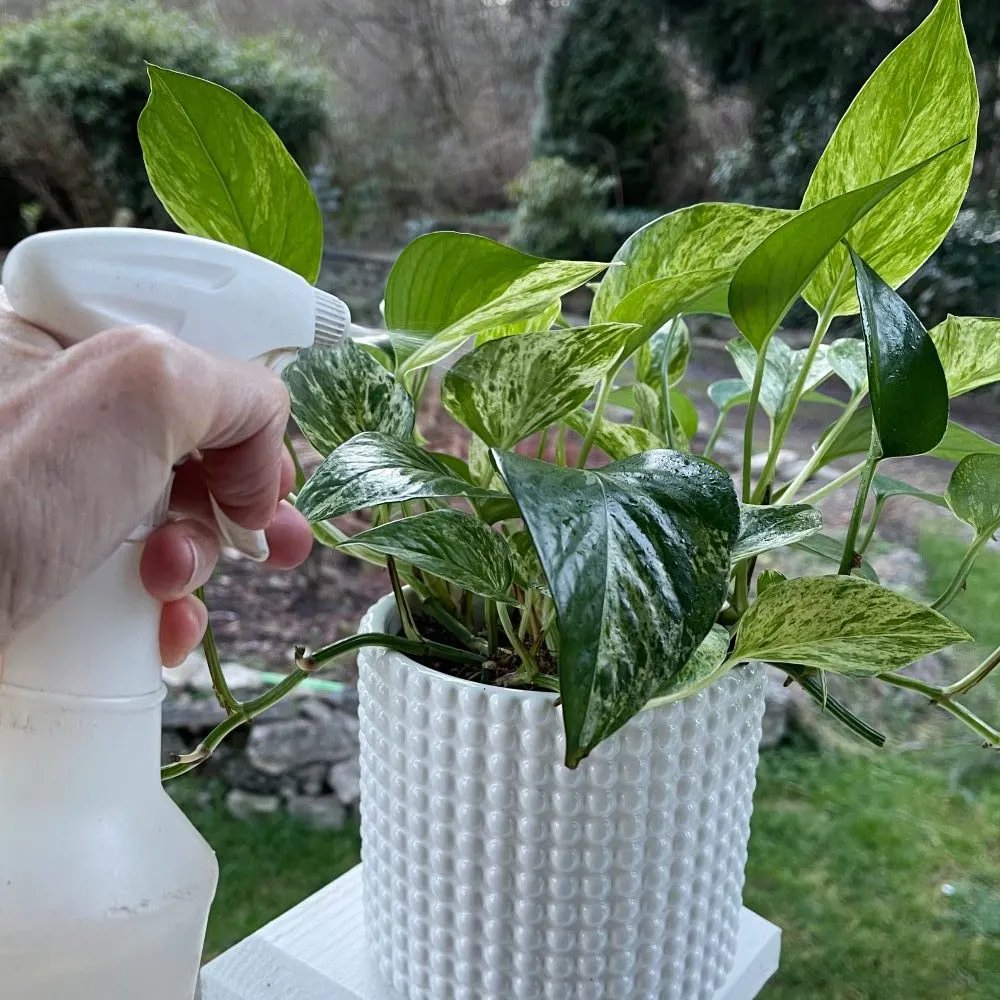
- To minimize the possibility of pests be sure to check all nursery plants before bringing them home. Carefully examine the top and bottom of the leaves.
- Do NOT purchase plants with signs of pest damage or disease.
- Quarantine all new plants until you are sure no pests live in them.
How to Propagate Calatheas:
- Propagation is best done through root and rhizome division.
- Seed propagation can be done but the seeds can be difficult to source.
- Dividing a calathea is easiest when repotting it in spring or summer.
- Un-pot the plant gently. Look at the root system. If the plant is mature you should see a natural parting in the leaves and roots. This is the two plants growing together.
- Each plant section will have its own rhizome. This is going to look like the stem growing straight down with roots coming off them.
- Gently pull apart the two rhizomes to separate them. If the roots are heavily intertwined cut them as necessary with sharp sterile scissors or small pruners.
Pot the two plant sections in separate pots. In 2 to 4 weeks the divisions should be settled and growing.
Non Toxic Plant:
- All calatheas are non toxic to humans and pets. Still it not recommended to chew any houseplant.
- Biting or swatting are not good for the health of the plant.
- Also you don't know what chemicals or pathogens are in the soil or fertilizers you use. So best practice is to keep houseplants away from pets and kids.
Follow Us:
Find us on YouTube, Instagram , Pinterest and TikTok! We love to Plant chat. We also comment, like and occasionally share your content to our daily stories. We’d love to see your plants. Share your joy in your houseplants. Happy Planting!
More Calatheas:
Read all about your favorite Calatheas. Here are a few to start with.
- Calathea Zebrina- The Zebra Plant
- The Calathea Medallion Care Guide and Plant Profile
- Calathea Roseoptica Care Guide
- the Calathea Makoyana Care Guide and Profile
- Calathea Rattlesnake Plant Profile and Care Guide
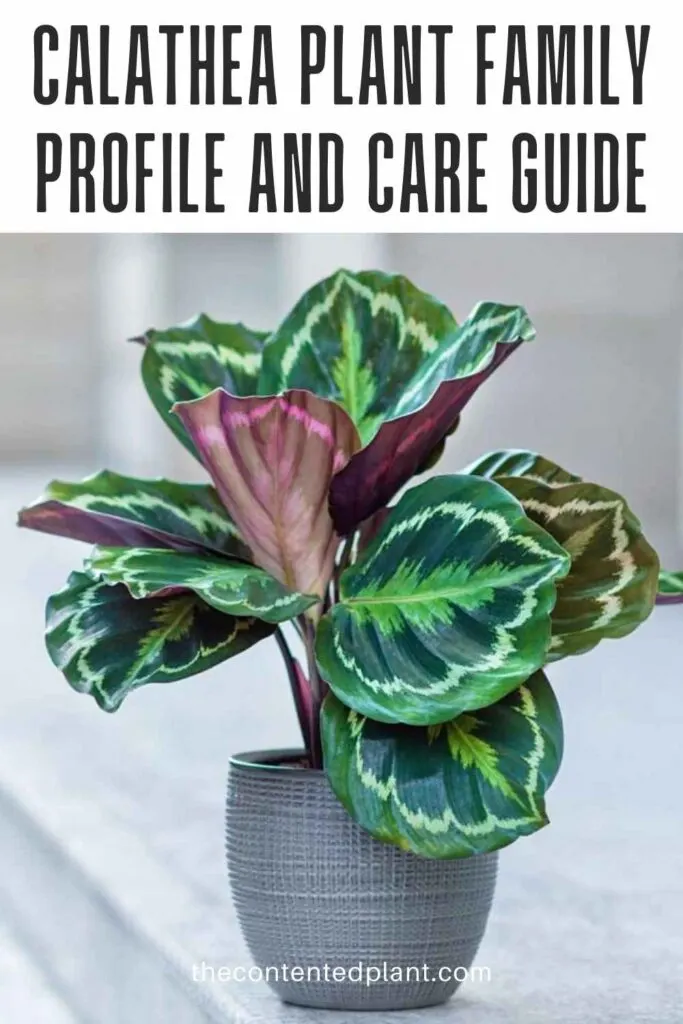

Venus Flytrap Care Guide - The Contented Plant
Wednesday 7th of February 2024
[…] Though the Venus Flytrap care is no more challenging than other houseplants to maintain, it does require very specific conditions, and a knowledge of its growth habits in order to successfully grow this plant (similar to the Calathea plants) […]
Growing Plants in LECA - The Contented Plant
Saturday 6th of January 2024
[…] with PH adjusted to the 5.5 to 6.5 range. I use distilled water for boiling and soaking LECA for my Calatheas to make sure the water is also free of minerals my fussy girls cannot […]
Fiddle Leaf Fig Care Guide - The Contented Plant
Thursday 5th of January 2023
[…] out our collection of Best Low Light Houseplants. And Read our Calathea Care Guide for more stunningly beautiful plants you must consider for your home. The plants pictured below are […]
Macodes Petola Jewel Orchid Care - The Contented Plant
Wednesday 17th of August 2022
[…] roots need air but cannot be dry. Rather like the rain forest understory Calatheas plants. If you can grow a calathea or Alocasia Polly successfully, you have a good chance of […]
Alocasia Polly - The Contented Plant
Monday 1st of August 2022
[…] Fussy? Well they are not QUITE as touchy as Calatheas like the Orbifolia or White […]